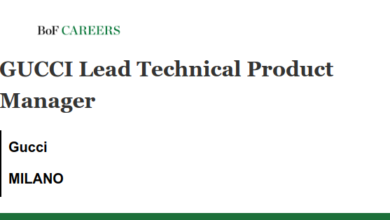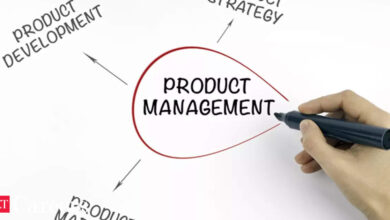How to Become a Product Marketing Manager

Product marketing managers bring to market a company’s shiny new digital solutions — things like apps, software and the latest upgrades.
In practice, that involves touching numerous bases. As you might expect, product marketing managers work closely with product managers and marketing departments, but they also work with sales. They have to study and define their given market, then do the same for their product. They’re also charged with implementing a captivating narrative that excites potential users to buy and continue using their organization’s tool or product.
What Is a Product Marketing Manager?
Product marketing managers are part data scientist, part competitive analyst and part storyteller. And it doesn’t hurt to know a thing or two about product design and user experience — all the better to help you collaborate well with the product manager who’s actually spearheading the build-out. Understanding business strategy is a boon, too, since all that research gathered by a product marketing manager could have larger strategic applications for a company.
What Is a Product Marketing Manager?
Product marketing managers coordinate the marketing activities involved in launching a new product or feature, often considering how the product is positioned and how its values and benefits are conveyed in messaging.
So while there’s nothing new about trying to drive success in the marketplace, product marketing represents a new synthesis of that wide-ranging skill set. And though a product marketing manager’s day-to-day responsibilities shift based on variables like a company’s size and influence, the role is becoming increasingly codified as it grows more ubiquitous.
We talked to three product marketing pros about how they transitioned into the field, what they do and how aspiring PMMs can break into the industry: Ashir Badami, director of product marketing at CREXi; Eugenia Alfornzo, product marketing manager at Trello; and Maya Shah, product marketing manager at Bluebeam.
Product Marketing Career Path: How to Get Into Product Marketing

Badami: I feel like I’m [still] working my way towards owning the title, though if I look back on my trajectory, I have been doing various aspects of what I’d consider product marketing throughout my marketing career.
I came into marketing sort of unintentionally. I got a Master’s in journalism, specifically magazine publishing. Publishing is almost, in my mind, equivalent to product marketing because you do a lot of business case analysis, strategy and understanding of the market in order to build an editorial product. And then you have to actually put it together. As a writer, you have to actually create the editorial pillars and create a unique voice. That equates to positioning. Then you take it to market and try to drive circulation and revenue.
So I started with that background, but I focused heavily on content communications and strategy, specifically within the realm of digital experience for a good while until I transitioned more into strategy. Then I got a lot more into traditional acquisition marketing for mainly growth-based companies.
But I started to feel like that was neither the direction that marketing should go nor the direction I wanted to take my career. That approach to marketing was really looking to bring in more and more and more customers [without proper focus on retention]. You have the ability to use technology to scale the way you bring folks into your ecosystem, but they don’t always stay; they move on.
They don’t stick around if you don’t have a clear value proposition and if your product and service aren’t designed with them in mind. So I transitioned into more work with product design, UX strategy and behavioral design, if you will, which all led me toward figuring out how to balance product components with marketing components. Ultimately, I started to see product marketing as the only real fit. But I probably always had product marketing in my thought process, which is to say communication, internal alignment and go-to-market strategy.

Alfonzo: I don’t necessarily think there is a traditional path in product marketing. Most of my product marketing counterparts and I really come from all different types of backgrounds. One colleague started through the support path; another used to work in public government. It depends on where your path lies and where your passions are. I actually started on the advertising agency side. I thought I was going to be like Don Draper in Mad Men for the longest time.
I had an opportunity to run a few media plans; one partner we worked with was Tumblr. And what really resonated with me, as somebody who was passionate about advertising, was that really good advertising compels people to engage with your product. I had the opportunity to join the ad operations team. So, trafficking ads, learning how a server is built, working with product, fixing bugs, working with customers.
In that realm, I found myself being really passionate about the numbers and telling a story with those numbers. And through that, there was an opportunity to shift my role from the ad operations side to the marketing side and continuing that path of being able to tell really good stories with numbers, and finding out what really differentiates your product from everybody else. And that started my path to a product marketing role.
Originally it was just a general marketing term. I’d never known what product marketing was, up until I took a couple of courses, went to a conference and learned that there’s a whole world of people who specialize in it.
But I’d say that product marketing doesn’t have a traditional path. Most people probably start in a marketing lane, but you can really come from anywhere. And, similar to a product manager, product marketing is definitely becoming more and more popular. More people know about it and more people are aware of the roles and responsibilities, but there’s still a lot of work to do there.

Shah: It’s such a new function that, relatively speaking, there really is no traditional career path yet. Some universities and programs are beginning to develop classes and curricula around it, but it’s relatively new. Most people in product marketing, including myself, have come to it from other disciplines and other functions, which I honestly think makes somebody more successful in product marketing. By nature, it’s one of the most cross-functional, cross-disciplinary roles you could choose. So having come from other focus areas gave me the perspective I needed to be successful.
I have a liberal arts degree, which taught me how to tell stories and how to talk to people. That was crucial in politics as well as marketing. After graduation I worked in politics for a while and eventually transitioned into more of a community relations and marketing role. I moved into traditional marketing from there and landed a content marketing role. I was really happy and really great at telling stories and creating campaigns about our products here at Bluebeam. But I quickly realized that, when I was creating stories and campaigns about the product, there was no consistent story of the product itself. Like, what is the product?
I moved into a product marketing role so that I could create the foundation from which the rest of the marketing team could generate demand. There was not a lot of consistency, and I think a lot of organizations find that different functions talk about the product differently. Whether you’re in a ten-person organization or a 10,000-person organization, there needs to be consistency of messaging, values and personas for your product. That’s the heart of product marketing — connecting all those different departments and functions.
Product Marketing Manager Roles and Responsibilities
Badami: We really sit at the intersection of product, sales and marketing, and, increasingly, customer support. But those first three are the critical ones. The degree to which you interact with one over another depends on the organization.
In a relatively young organization with a fairly new product that’s just establishing product market fit, you might spend a lot more time working with the product team to validate and drive the product strategy. In my experience, that means doing a fair amount of user and market research to begin identifying the real market needs, both expressed and unexpressed.
People will always tell you their problems, but you have to anticipate issues and opportunities even beyond what a client identifies. Product marketing serves that role a lot.
In more mature organizations, you might be working with product teams that already have UX strategy or UX design, so you don’t necessarily have to do a lot of that. You might focus more with the sales team, helping frame the message and value of the product, so that they can sell effectively and consistently. So it’s more of a delivery focus versus a definition focus.
But if I were to break it down, I’d say there are three key areas: market definition, product definition and adoption.
The definition side is working very much with the product team. What should we build? Is there a market for it? If so, how do we know the actual quantifiable component? If I build this particular function, what’s it worth in the market today? So there’s some level of marketing segmentation, pricing and business case strategy around it. That would cover both the market and product definition.
So you’re really helping them build and frame the narrative, situate it within the context of the customer’s needs, so that when you’re having these conversations with customers, you’re able to show fluency with the space and have them sign on. This is where a lot of the content marketing and content components kick in; you’re essentially building a content strategy for prospects or leads who are entering the sales loop.
The last thing that I think should become part of the product market plan is adoption awareness. When people come on board, are we paying attention to their adoption? Are we giving them the right education and understanding of the product and what it can do? Are we navigating them to the right experience so that they not only create an account, but start using the product in a way that will help them appreciate the value quickly so they remain long-term users?
Alfonzo: Every company is totally different, particularly in terms of where the line is drawn between the product manager and the product marketing manager. How I envision product marketing is, they’re in charge of the product narrative externally. So outside the company, they’re the ones who are coming up with a strategy — the positioning, the messaging, the competitive research — and really getting a good sense of what the market is doing and the product they’re focused on.
That means making sure your messaging resonates throughout the company. So particularly with sales, for example, you have to make sure your narrative is compelling to customers. Sales people [need to] feel confident telling that story. And they’re bringing information back to you in terms of feedback from customers on whether or not it resonates, and also what the competition is offering, which might make you reconsider your positioning.
That gives direction that the product marketer can synthesize and then go to the product team and say, “Hey, this narrative isn’t working. We need to adjust it. These are the things that we should be building to help propel our narrative and make sure we’re still ahead of the competition.” So internally, it’s a lot of herding cats, trying to get everyone into agreement, but particularly with the product team, I always try to be in lockstep with the product manager. I always try to learn the product as much as I possibly can, just so that the product manager really feels like I’m looking out for them and advocating for the product.
That creates a great relationship, where the product manager wants to bring me to the table and be part of roadmap and priority decisions and customer calls, because then I can speak to the market repercussions if they were to release a certain type of feature. I can talk to different customers and get instant feedback. I’m reading their pulse on how those decisions will reverberate in market.
So I see it as a balance between products and sales. And then obviously in the marketing aspect it’s about really resonating with the customer and making sure that any content you write — whether it’s websites, blog posts or emails — is consistent and resonates with your customers, so that you’re able to continue that relationship, enable advocacy with those customers and hopefully continue to drive more business.
Shah: At the core, the fundamental responsibility is to align the sales, marketing and product team around consistent messaging, positioning and stories in order to better sell the product.
That involves a lot of different day-to-day level tasks, including positioning and messaging, go-to-market strategy, product launches, a lot of customer research, market research and competitive analysis. What all these initiatives have in common is, you can’t do them alone. Almost every department in an organization is touched by a product launch. So, as a product marketing manager, the ability to influence and empower other people without direct authority is really critical.
That’s maybe the most valuable kind of influence one could have as a professional because being able to influence without direct authority is all about trust and peer-to-peer credibility and relationship-building. And I’m very much a people person. So that appealed to me: being the nexus point of all of these different departments and functions working together to launch and sell a product.
You have all these inputs and you have to be really good at synthesizing these inputs into actionable strategy. So the product marketer is an amazing place to be able to really inform business strategy for the company.
Product Marketing Collaboration With Product Managers
Badami: I prefer to be involved pretty early with the definition of new products and services. I don’t play a heavy role in the actual product development/product management process, which is, let’s go build a thing. I’m helping more with why we’re building the thing. It’s less about the how, and more about the why and the what.
I’m asking, What are we building? And how do we do it? Is there a need for it? So I’m heavy on the research side. Increasingly, once the research is done and the product management team is working towards building, I’m actually doing the go-to-market planning.
I spend about 30 percent of my time on research, 40 percent on go-to-market, and then 30 percent on the sales enablement side.
Alfonzo: That really depends on the organization. I always try to work with organizations that are a bit more flexible on that aspect. I know sometimes product managers want to be a bit more closed off and not let too many cooks into the kitchen. So I always try to find a balance between totally respecting that they need to make the decisions that they think are best, but [making sure] they’re open to hearing and understanding feedback.
My relationships with product managers are definitely always ongoing. We always have roadmap conversations, roadmap check-ins. And then when we start developing, like when we’re getting mocks from the lead designer, I provide feedback on copy.
In my experience, it’s definitely always been part of the beginning. It’s not that the product manager gives me a finished product, throws it over the fence, and then I take it and run with it. We’re building it together, and by the time it’s ready to go to market, I have all the context. I have all the research, the product manager feels good about it. Then I come up with the go-to-market strategy and we’re really in line to launch something.
Shah: I have product manager colleagues who work with their teams very differently because their products are at a different level of maturity. Product marketing is super dynamic and constantly changing based on the maturity of your product and the size of your organization, plus a bunch of other different factors.
Right now I’m specifically working on very early-stage products that are still in discovery, which means I work really closely with the product manager, the designer and the engineer to understand our market fit and to do customer interviews — customer research validation of what we think will be valuable and how we can really build and sell it. So right now, I’m involved closely from the very beginning.
There are other product marketing managers who get the product information at a handoff point and then focus much more on go-to-market and launching a product, and have a lot more intimate involvement in the related marketing campaigns. It really just depends on what kind of gaps exist in the organization.
Product Marketing Manager Vs Product Marketing Specialist
Badami: Specialists are more entry-level, just coming into the space. Maybe they have two years of experience where the manager might have two to four years. I personally don’t see the point of splitting it up even more. We just focus on the product marketing manager and then levels of seniority after that. It’s like a marketing assistant versus a marketing manager.
Alfonzo: I imagine the product marketing manager is more senior and maybe a specialist is maybe someone just starting out. Most product marketing manager roles I’ve applied to in the past ask for three to five years of experience in product marketing.
Shah: I’m not sure how it works in every organization, but I have seen similar structures. Usually a product marketing specialist is at the beginning of their career, and they work on a product marketing team that’s managed by a product marketing manager. And that product marketing manager works with other team leaders to make informed critical decisions about the product and launching the product.
The specialists support the team in all of the tasks that have to be done. Because in building and launching a product, there are a-million-and-one tasks that need to be done at all times. And especially product marketing, which sits at the center of all these different internal groups, everybody wants something from you at all times. So having different levels of experience on the team and different abilities to help support each other is really important.
I came on board at Bluebeam as a marketing specialist, then moved into a product marketing specialist role, then, years later, the product marketing manager. It’s pretty standardized throughout the industry that the PMM is the decision maker for their product within their function.
Product Marketing Trends
Badami: Product marketing is now becoming more popular, and there’s a natural tension that’s starting to happen between product management and product marketing managers, and who owns what?
I see us starting to get more involved in pieces of the puzzle that product management doesn’t look at or have time for. There’s a lot of strategic planning that deals with taking something to market and making sure we’re building valuable things. So I see this intersection of multi-disciplinary marketing people, like myself, with UX strategy, a lot of design thinking and design tools, sprint planning and working heavily with product qualified leads.
You’ll see product managers pushing for ownership of that at some companies, but I think product marketing managers like myself, who have a background in product design or are conversant in it, are getting more involved with a level of: Okay, it’s in the market, but now we’re going to continually drive towards deeper engagement and adoption.
An interesting thing that nobody has nailed yet and that will continue to grow is product marketing metrics around go-to-market. GTM is a much bigger piece than just a product launch; it’s a different way of thinking about overall market strategy. But how do we bridge the gap between the market strategy and the actual launch, and being able to do that in a way that’s independent of current tools that the marketing teams use?
Alfonzo: [One] interesting trend is leveraging the executive team and developing more thought leadership pieces to go in conjunction with a product launch. In terms of getting more eyeballs and interest from the press, that’s a really big opportunity. I’m definitely interested in seeing the impact it would have for upcoming product launches.
Shah: Product marketing as a role is still very much evolving, but it’s getting more mature in its evolution because product marketers are now seen as both tactical and strategic. Sometimes it’s easy to look at a product marketing team and see us as producers of artifacts, like product positioning guides and competitive analysis reports. But the combination of being able to synthesize all the information that goes into these artifacts, from all these different audiences internally and externally, from our customers and from the market, really puts us in this awesome position of being able to inform strategy. So the strategic value of product marketing is being recognized more and more, which is really exciting to me. And I would just push for other product marketing managers.
Product Marketing Career Resources
Badami: If you’re interested in the space, you should be already connecting with organizations like the Product Marketing Alliance. They have a Slack channel and website. They’re doing a lot of event programming now and it’s really bringing the community together. Mind the Product is also great, to keep the pulse of what the product management stage is talking about. Beyond that, in terms of skill set, I wish I had spent more time before — and I’m bolstering it now — doing basic data science certifications and courses.
I don’t think product marketing managers should spend all their time in data because we should also be outside the building. But under the rubric of research, which is an area that many organizations are just not spending time on, a good product marketing manager should get training in qualitative research methods. So whether that’s through a user research boot camp or other method, they should get some quantitative data skills. So, basic Excel, and if you want to go further into some heavy hitter data science toolkits, great — understanding how to pull the right data without relying on somebody else. Understanding front-end web work is always good, too, especially if you’re going to interact with the e-commerce or web application space.
The other piece is reading widely. Everything Geoffrey Moore has written is great, from Crossing the Chasm to Inside the Tornado. He literally wrote the book on product marketing. Books on technology and marketing are critical, but you also want to read about human psychology and mixed methods research.
Alfonzo: The Product Marketing Alliance is great. It’s an open forum of some 2,000 product marketers [where they] can talk about their work, pose questions, share website recommendations and gather feedback.
There’s also the Pragmatic Marketing course. It’s five days with a different course each day, and you have to complete two to become certified. That was the foundational place where I learned all the product marketing knowledge, strategy and context. And I used that to build my framework in terms of coming into a role.
And a book that really helped me build foundational product marketing knowledge is Crossing the Chasm. It’s about how, in the normal cycle of product adoption, you have your early adopters ready to experiment. But the period between the early majority and the late majority, there’s this huge chasm because they need more proof.
Shah: I am still exploring this, too, because I still want more information and more mentorship opportunities. I’m part of the Product Marketing Alliance, which so far has been helpful.
I learned what product marketing is and does just by nature of filling in gaps and asking questions, especially of folks who have roles that are related but not exactly the same. So I spent a lot of time spent with my product designers and marketing counterparts to understand what gaps they have and where product marketing fit.
How to Transition into Product Marketing
Badami: Communication skills are critical. Understanding that organizational design is a huge component of your success and your ability to influence, that’s massive. You can’t do the job of product marketing without being able to work really well with people. At the same time, it’s not just about being nice and being able to communicate verbally and on the page. It’s also about being able to influence and facilitate consensus, so you have to have strong communication and self-awareness.
Alfonzo: For me, it’s really all about how well you know the market and how well you know the customers, and the way you learn that is by really focusing on data.
Data is frequently deprioritized in terms of market knowledge and customer understanding. People will optimize the heck out of a website, they’ll optimize the heck out of conversion rate, but they don’t really ask the bigger picture questions: Who are these [users]? Where are they coming from? What do they care about most? For me, as someone who worked on the ad side with no real marketing experience besides working a little bit in media, that’s what started to resonate with my colleagues — the fact that I was looking at reports and trying to tell a really good, resonant story by using the numbers.
Even if you’re at a company where they don’t have a PMM position available, stay focused on the data. Also, practice telling a good story with those numbers; that will make you stand out and make people depend on you. They’ll also want to bring you into the conversation because they understand you’re the subject matter expert. And that’s what a product marketer really is. They’re the subject matter expert for the customer, and they’re supposed to advocate for the customer.
Focus on trying to learn as much as possible about your customer, creating reports, creating either a blog post or an email or a presentation where you’re really able to elevate what you can do; practice telling that story. That’s how you’ll really stand out and develop a portfolio of projects that, even if it’s not at your current company, you can take to your next role. That’s what marketers really care about: How good are you at telling stories? How good are your at understanding your customer? And what kind of strategy can you build by knowing those numbers?
Shah: Things are always changing. If you’re not dynamically adjusting your product strategy and approach and messaging based on feedback, then you’re not going to be competitive, and you’re certainly not going to be customer-centric. Change is the constant you can count on. If you’re not comfortable with ambiguity and things shifting all the time, maybe don’t do product marketing. On the flip side flip, the opportunity to define your own role — because product marketing is so different from organization to organization and product to product — is exciting.
I highly recommend putting a big emphasis on relationship-building and the ability to gain trust and credibility without directly managing others.
And brush up on the business side of things. I’m excited that product marketing is moving into a more strategic realm. But it also means that I need to really up my skill in terms of business decision making, whether it’s packaging or pricing or financial modeling. That’s where I’m trying to focus my personal development and learning right now.



